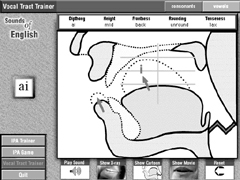The University Record, January 31, 2000 Editor’s note: This article is one in a series on U-M projects that have been recognized by the Computerworld Smithsonian Program, announced in a Sept. 27 article that can be found on the Web at
By Theresa Maddix

“Phonetics: Sounds of English (SoE)” has the potential to help children with speech problems and people learning English as a second language. But, San Duanmu, associate professor of linguistics, originally set up the game-like program to spark interest in linguistics courses.
The computer-based pronunciation tutor combines common aspects of linguistics study, such as the International Phonetic Alphabet table, with X-rays, Quicktime movies, and cartoon drawings of various sounds and games. The result is an empowering environment “for people who feel they don’t know how” to make certain sounds.
“The goal of the program,” Duanmu says, “is to show people they can move their articulators any way they want to.” Articulators are the elements of the mouth and throat used to create sound. “There are about eight places you can control.”
SoE involves two processes. The first is “teaching students to make sounds.” The second is encouraging students “to keep on this program as long as possible.” Practice is the real key to mastering new sounds.
Prior to developing the program, Duanmu felt that “except for a small number of people with a real interest in linguistics,” students could find introductory classes boring. “The most popular way of teaching the Phonetic Alphabet table was by using a book with still pictures and an overhead.” Duanmu created SoE as “a spare time hobby” to get more students interested in his field.
“This is the only product of its kind that offers graphics and animation,” Duanmu says, still with an element of surprise. When he first had the idea to design the program, he thought, “This is obvious. Why aren’t people doing this?”
He rationalizes that other programs don’t exist because “most graphic designers work on more profitable projects” or because most linguistics experts “lack the educational background” in computer science.
In the initial phase of SoE, Duanmu worked with a graduate student to write the program using Hypercard on a Macintosh computer. In the second phase, Duanmu worked with a student who drew the cartoons, gathered the X-ray images and made the videos. The Office of Instructional Technology also provided technical support in choosing what software to use for the programming. “We wanted to be able to use the program on both Macs and PCs without any changes.”
In the future, Duanmu hopes to reprogram SoE in a more common computer language. He also envisions ways to simplify it for younger children by using less complicated terms and different graphics. The program also could easily be shifted to “Sounds of Spanish,” “Sounds of Japanese” or any spoken language.
Duanmu looks forward to the day when “the University can have a whole set of language development software done by experts.”
For right now, he’d like a linguistics classroom with 15 computers so that a class of 30 students can use SoE right in class.

